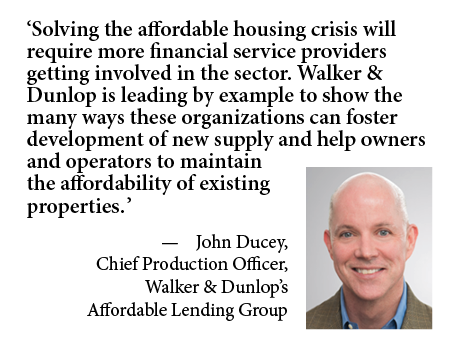By John Ducey, chief production officer of Walker & Dunlop’s affordable lending group
Private industry and the federal government are rallying to recover ground lost to a housing affordability crisis that has been decades in the making.
Nearly half of the nation’s renters, 46 percent, are housing cost-burdened, which the Census Bureau defines as those families paying 30 percent or more of their income on rent and utilities. The burden is higher for some, with nearly one in four families (23 percent of Americans) paying half or more of their income for housing.
The situation calls for a change in tactics, a recognition of recent policy failures and a shared commitment to double down on programs with proven efficacy. As a nation we must ask, what can we do differently to put more homes within reach for the growing ranks of Americans who struggle to meet basic housing costs?
A Building Problem
The gap between housing costs and strained household budgets has widened due to both insufficient supply and wage stagnation that has fueled demand for affordable housing. The larger of the two issues — a lack of supply — traces chiefly to the 2008 financial crisis, which put a stopper on construction lending across the housing spectrum. As lending resumed, developers tended toward high-end apartments and single-family homes that offered larger returns. The affordable housing projects completed in the next few years fell far short of meeting demand.
On the demand side, wages have been losing a 40-year battle with inflation that has withered the spending power of middle- and lower-income earners. More recently, the housing shortage has enabled landlords to rapidly raise rents. Average rent climbed 18 percent over the past five years, according to Federal Reserve data. The problem is more acute in some markets, many of which saw average rents skyrocket 10 percent or more in the past year alone. With annual wage growth closer to 4 percent, it is easy to see why more and more people struggle to afford market-rate housing.
The pandemic exacerbated these issues in a number of ways, from slowing housing construction pipelines to hampering many workers’ ability to perform their jobs. COVID-era eviction moratoriums and other measures enacted to safeguard struggling renters had unintended consequences that weakened developer and investor interest in affordable projects. Federal funds for emergency renter assistance went directly to states and communities, many of which lacked the expertise and resources to screen applicants and efficiently distribute aid. This marked a tragic lost opportunity for a more efficient distribution of these important rental subsidies, which would have flowed through the existing channels for Section 8 rental assistance requiring temporary minor changes, instead of requiring whole new programs jurisdiction by jurisdiction.
Programs that Work
The good news is that two pillars of affordable housing that foster the development and preservation of affordable housing have worked well and continue to perform.
The Low-Income Housing Tax Credit (LIHTC) program, which subsidizes the construction or renovation costs for qualifying projects, is the key vehicle for developing new affordable housing. Section 8, or the housing choice voucher program, assists families and elderly and disabled individuals with very low incomes to obtain safe housing. The LIHTC and Section 8 programs offer a ready framework to support a larger and desperately needed groundswell of new development and renter assistance.
In the nation’s capital, lawmakers from both sides of the aisle are urging passage this session of an extension to the 12.5 percent LIHTC allocation increase that expired in 2021. Restoring the allocation increase would allow many projects waiting on housing credits to proceed immediately. The same representatives have called for a provision to lower the 50 percent test to 25 percent for communities’ private activity bond requirements to access housing credits. Lowering the test would give states flexibility to move on many shovel-ready projects.
Other examples of federal progress to address housing affordability include the Department of Housing and Urban Development’s awarding of more than 19,000 new housing choice vouchers in September. In October, the Biden administration announced several affordable housing advancements including $3 billion forward commitment allowances for both Fannie Mae and Freddie Mac. This means each agency can commit an additional $3 billion each year to affordable projects that will not count toward that agency’s $75 billion purchase cap. These and other program enhancements will help to increase the supply of affordable housing, but only if developers, lenders, investors and other members of the nation’s business community do their part.
Walker & Dunlop’s mission is to help solve this national crisis by expanding our platform and the ways we serve clients in the affordable housing arena. This fall we welcomed one of the top investment sales teams in the affordable housing space, led by managing directors Aaron Hargrove and Eric Taylor. Just one year ago we acquired Alliant Capital, an investment manager focused on affordable housing through LIHTC syndication, joint venture development and community preservation fund management.
This growth not only expanded the services we offer; they also improved the insight we can bring to the table and introduced opportunities for problem-solving and collaboration across a vast range of expertise. We’ve assembled a full suite of services that range from debt financing and LIHTC equity to affordable housing preservation, appraisals, development support and construction management, affordable compliance software solutions and investment sales and advisory.
Solving the affordable housing crisis will require more financial service providers getting involved in the sector. Walker & Dunlop is leading by example to show the many ways these organizations can foster development of new supply and help owners and operators to maintain the affordability of existing properties.
Making Progress

Lawson House will undergo an extensive green renovation and continue to provide affordable housing.
An example of such efforts is the Lawson House project Holsten Real Estate Development Corp.’s 24-story renovation of a former YMCA building in Chicago. Alliant Capital closed an $82 million investment in the project, which will provide 409 studio units and supportive services for individuals with special needs or at risk of homelessness.
The structure first opened in 1931 as the Victor F. Lawson YMCA to serve as a single-room-occupancy hotel. The YMCA sold it to Holsten in 2014 with the expectation it would remain affordable for at least 50 years. The two-year modernization, slated for completion in October 2023, will convert single-occupancy units into studio apartments, each with a kitchen and bathroom. Amenities will include social services, laundry facilities, community rooms, a fitness center, a computer lab, library, gymnasium, conference rooms, roof decks, storage lockers, a catering kitchen and community meals provided by an outside charitable organization.
The Walker & Dunlop team works on 100 or more projects like Lawson House each year, and, in 2021 alone, we originated over $1.5 billion in affordable debt and $10.2 billion of workforce and affordable financing combined. Our mission is to assist with rehabilitation, help owners refinance an affordable community, arrange a construction loan or permanent financing — in short, to meet the financial objectives of our clients that create or preserve affordable housing.
As individuals, Americans can make a difference in housing affordability by urging their elected representatives to support the expansion of the LIHTC and Section 8 programs. For those of us in financial services, we can smooth the way and speed the process for the developers and investors who create new affordable homes. From debt to equity and investment sales, we can provide capital solutions that make new affordable housing communities possible.
— Walker & Dunlop is a content partner of REBusinessOnline. For more articles from and news about Walker & Dunlop, click here.


